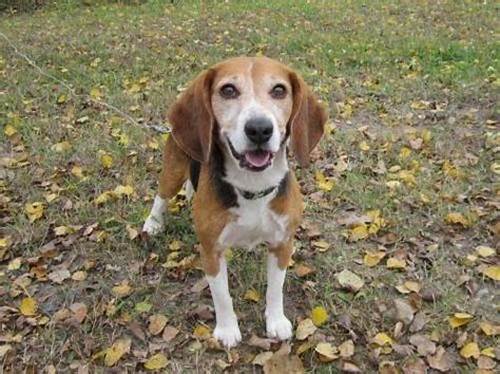
The Bassador is a mixed breed dog-a cross between the Basset Hound and the Labrador Retriever dog breeds. Loyal, sometimes stubborn, and always sniffing around, these pups inherited some of the best traits from both of their parents.
Bassadors go by several names, including Basset Lab, Basador, and sometimes even Bassetdor. Despite their status as a designer breed, you may find these mixed breed dogs in shelters and rescues, so remember to adopt! Don't shop!
Bassadors come from two very different parents, so their perfect living situation will depend on the individual dog. In general, Bassadors love attention, especially from their favorite person, and will need to live in a place with plenty of space to roam. If you want a dog with a very unique look who's loyal to a fault, the Bassador could be the dog for you!
More About This Breed
Highlights
The Bassador is a mixed breed dog. They are not purebreds like their Basset Hound or Labrador Retriever parents.
Bassadors can come in a variety of colors and patterns. If they have a yellow Lab parent, their coat may contain more yellow. If they have a black Lab parent, their coat may turn out more black. They may also have colors from their Basset Hound parent, including white, brown, and black.
Many Bassadors have thick coats that protect them in cold or hot weather, though they tend to shed a lot.
Since the Affenhuahua can be easily injured by overly exciteThe Bassador temperament can vary a lot depending on whether they take after their Lab or Basset Hound parent more. Generally, they are sociable and loving.
Bassadors tend to have high prey drives. They may chase after smaller pets, though with proper training, socialization, and slow introductions, they can get along with other animals.
History
The Bassador mixed breed may have existed naturally over the years, but designer breeders started intentionally mixing Basset Hounds and Labrador Retrievers in the late 1990s or 2000s, likely in North America. Once breeders saw a demand for this unusual looking--but still adorable!--dog, they began to deliberately create more Bassadors.
Since the Basset Hound and the Labrador Retriever are such different dogs, breeders aren't likely creating Bassadors for a certain aesthetic; even puppies from the same Bassador litter can look like complete opposites!
Even though the Bassador breed got its start as a designer breed, some have ended up in shelters or in the care of rescue groups. Consider adoption if you decide this is the breed for you.
Check your local shelters, look up Bassador rescues, or check with breed-specific Basset Hound or Labrador Retriever rescues, as they sometimes take in mixed breed dogs and find homes for them.
Size
As the Bassador is a relatively new breed, there are few standards when it comes to size. That said, as a mix between Basset Hound and Labrador Retriever parents, you can expect Bassadors to be on the medium- to large-side.
Most Bassadors weigh in between 45 to 70 pounds, and they range in height from 13 to 20 inches at the shoulder. That said, many can be larger or smaller.
Health
The Bassador breed is predisposed to some of the same conditions that the Basset Hound and Labrador Retriever also face. While most are generally healthy, some may be prone to a few health issues, which is why it is important to maintain good care and regular veterinary checkups.
Some of the more common health problems Bassadors suffer from include:
Hip dysplasia
Back injuries
Glaucoma
Bloat
Care
As with all dogs, you should keep up with your Bassador's regular veterinary checkups to detect any health concerns early. Your vet can help you develop a care routine that will keep your dog healthy.
Bassadors are prone to weight gain, and their energy levels can vary from dog to dog; some have the higher energy of a Labrador Retriever, while others prefer to take it slower like a Basset Hound. Make sure your dog gets at least one good half-hour- to hour-long walk per day with a few good, active play sessions and shorter walks mixed in.
Check their ears for debris and pests daily and clean them as recommended by your vet. Longer-eared Bassadors will need extra care taken for their ears to prevent infection. Trim your dog's nails before they get too long--usually once or twice per month. They should not be loudly clicking against the floor. Your groomer can help with this. Also be sure to brush your Bassador's teeth daily.
Your main concern when it comes to your Bassador's health will be regulating their weight. Basset Hounds love to munch, and both the Labrador Retriever and the Basset Hound are prone to weight gain if they do not receive the adequate amount of exercise.
:max_bytes(150000):strip_icc():format(webp)/what-horses-eat-that-keep-them-healthy-1886504-FINAL-5ba8dd3746e0fb0025eb2cb4.png)
:max_bytes(150000):strip_icc():format(webp)/horse-eye-resized-56a4dbf03df78cf77284fe95.jpg)
:max_bytes(150000):strip_icc():format(webp)/Horse-grooming-GettyImages-495726400-5876f27d5f9b584db351222e.jpg)
:max_bytes(150000):strip_icc():format(webp)/close-up-of-hand-holding-parrot-705172843-5b52bc4ec9e77c0037b6e5a4.jpg)
:max_bytes(150000):strip_icc():format(webp)/GettyImages-579524112-5c77331146e0fb000140a3a6.jpg)
:max_bytes(150000):strip_icc():format(webp)/budgerigarsonrope-331834_1920-5b628213c9e77c00255b32bc.jpg)
:max_bytes(150000):strip_icc():format(webp)/GettyImages-106887241-58325bc03df78c6f6a9a2ed2.jpg)
:max_bytes(150000):strip_icc():format(webp)/GettyImages-878015800-06106157c9d34a2081db4abcae8699b1.jpg)
:max_bytes(150000):strip_icc():format(webp)/hungry-cat-57b72fac5f9b58cdfda11a62.jpg)


:max_bytes(150000):strip_icc():format(webp)/4374985466_59c7f6545b_o-8b4f24f2f3e544349fe537fde58cfad0.jpg)
:max_bytes(150000):strip_icc():format(webp)/GettyImages-9298737261-500c5a2fba4248f89d1c17a33bf438f7.jpg)
:max_bytes(150000):strip_icc():format(webp)/veterinarian-and-owners-examining-dog-in-vet-s-surgery-164853745-dbecbdb691d549d79487d84356920cf4.jpg)